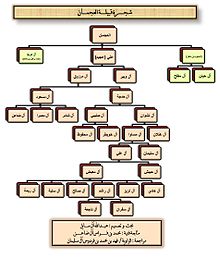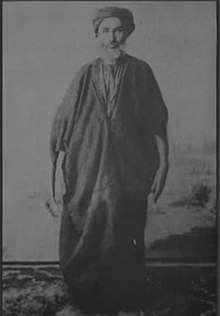| Revision as of 21:41, 24 March 2008 edit72.160.164.206 (talk)No edit summary← Previous edit | Latest revision as of 16:14, 21 October 2024 edit undoMonkbot (talk | contribs)Bots3,695,952 editsm Task 20: replace {lang-??} templates with {langx|??} ‹See Tfd› (Replaced 2);Tag: AWB | ||
| (182 intermediate revisions by more than 100 users not shown) | |||
| Line 1: | Line 1: | ||
| {{Short description|Arabian tribal confederation}} | |||
| {{Unreferenced|date=May 2007}} | |||
| {{more citations needed|date=February 2019}} | |||
| '''Al-Ajman''' or '''al-'Ijman''' ({{langx|ar|العُجمان}}, singular Ajmi {{langx|ar|العجمي}}) is an ] tribal confederation in the ], with Ajman spread across ], ], the ] and ].<ref name=":0">{{Cite book|url=https://books.google.com/books?id=P8yhCgAAQBAJ&pg=PA18|title=Historical Dictionary of the Bedouins|last=Suwaed|first=Muhammad|date=2015-10-30|publisher=Rowman & Littlefield|isbn=9781442254510|language=en}}</ref><ref>الموسوعة العربية الميسرة، 1965 م</ref> | |||
| {{Infobox tribe|name=Ajman|local name=العجمان|image=|caption=The flag of Ajman is a cloth or fabric that changes color and/or hue from time to time and writes the name of the tribe or a sub-tribe or a sub-sub-tribe of Ajman|ethnicity=]|nisba=Banu Yam|language=]|religion=]|location=*] | |||
| '''Al-'Ajman''' or '''al-'Ijman''' ({{lang-ar|'''العجمان'''}}, singular "Ajmi") are a ] tribe of northeastern ], with members spread across ], ], ], and the ]. | |||
| *] | |||
| *] | |||
| *] | |||
| *]|image_size=300px}} | |||
| ==Origin== | |||
| The tribe is an offshoot of the tribe of ], the principal tribe of ] near ]. The 'Ajman separated from Yam sometime in the 18th century, along with another sub-tribe known as ]. Both tribes migrated towards the east, with the Ajman settling the region between ] and ], and Al Murrah ending up roaming regions further south on the border of the ] desert. Unlike their parent tribe of Yam, who are predominantly ] ], the Ajman and Al Murrah are entirely ]. | |||
| ] | |||
| Al-Ajman is a ] Arab tribe that is descended from ] tribe. Most of Ajman left their nomadic life and lived in northeastern of Saudi Arabia.<ref name=":0" /> | |||
| ==History== | |||
| The 'Ajman were noted for their strength in battle and were important players in the wars and politics of eastern and central Arabia in the 19th and early 20th centuries. Their most famous leader (or ''shaikh'') during the 19th century was ], who is still well known in Arabian tribal lore, and who was noted for his poetry as well as aptitude in battle against the ]. The 'Ajman, however, were defeated by ], the second Imam of the ], who later married into the tribe. Later on, they supported the cause of the ] branch of the ] against their cousin ], the founder of ]. | |||
| ] | |||
| The Ajman were noted{{by whom|date=January 2020}} for being important players in the politics of eastern Arabia in the 18th and early 20th centuries. Their most famous leader (or ''sheikh'') during the 19th-20th century was ], who is still well known in Arabian tribal lore.<ref>{{cite news|author1=Mustafa Al Labbad|title=The new Saudi power triangle|url=http://www.al-monitor.com/pulse/politics/2015/01/new-saudi-arabian-power-triangle.html|accessdate=24 April 2017|work=Al Monitor|date=27 January 2016|archive-url=https://web.archive.org/web/20170425120452/http://www.al-monitor.com/pulse/politics/2015/01/new-saudi-arabian-power-triangle.html|archive-date=25 April 2017|url-status=dead}}</ref> He was noted for his poetry and is often known as the maternal grandfather of the current ] ]. In 1861 the Ajman were defeated by ], the Imam of the ], after challenging his rule in the 1850s.<ref>{{cite thesis|author=Bilal Ahmad Kutty|title=Saudi Arabia under King Faisal|url=https://core.ac.uk/download/pdf/144512812.pdf|access-date=30 April 2021|location=Aligarh Muslim University|degree=PhD|date=1997|page=46}}</ref> Faisal bin Turki later married into the tribe. Later they supported the cause of the ] branch of the ] against their cousin ], the founder of ]. | |||
| ] | |||
| A section of the Ajman led by ] joined the ] movement in |
A section of the Ajman led by ] joined the ] movement in 1900, providing military support for Ibn Saud, but later rebelled against him.<ref name=rkk>{{cite thesis|author=Rayed Khalid Krymli|title=The political economy of rentier states: A case study of Saudi Arabia in the oil era, 1950-1990 |url=https://www.proquest.com/docview/304080655|access-date=1 June 2021 |location=The George Washington University|page=125|degree=PhD|date=1993|id={{ProQuest|304080655}} }}</ref> The Ajman and their allies from the tribes of ] and ] were defeated by Ibn Saud in 1929 in the ], which put an end to the Ikhwan rebellion.<ref name=rkk/> | ||
| Nearly all the Ajman have abandoned nomadic life and have settled in the ], |
Nearly all the Ajman have abandoned nomadic life and have settled in the ], particularly in the ] of Saudi Arabia. Their main tribal territory is known as ] ("the valley of the Ajman"), spanning ] governorate to the town of Judah. | ||
| It is disputed whether the ] in the ] is named after the tribe of Ajman or the ] (Persians).<ref>{{cite book |author=Gwillim Law |title=Administrative Subdivisions of Countries |publisher=McFarland |orig-year=1999 |isbn=9780786460977 |edition=ebook |page=382|lang=en |url=https://books.google.com/books?id=nXCeCQAAQBAJ&pg=PA382 |year=2011}}</ref><ref>{{cite book |author=William Lancaster |author2= Fidelity Lancaster |title=Honour is in Contentment |publisher=Walter de Gruyter |year=2011 |isbn=9783110223392 |page=513 |url=https://books.google.com/books?id=Le0Ryxzh7cQC&pg=PA513}}</ref><ref>{{cite news |title=علي المطروشي: هذه هي الحقيقة في أصول مسميات الإمارات |url=https://www.albayan.ae/sports/2005-10-11-1.983993 |work=www.albayan.ae |date=11 October 2005 |language=ar}}</ref> | |||
| {{Saudi-stub}} | |||
| ==Language== | |||
| ⚫ | ] | ||
| The Ajman tribe, alongside their cousin tribe ], have an Arabic dialect that is part of the southern ] group. This dialect group is characteristic of ], the parent tribe of Ajman. The tribe's dialect defers from neighboring east Arabian bedouins, such as ] and ], as it possesses some south Arabian features like the "-ish" feminine suffix.<ref>{{cite book |last1=Ingham |first1=Bruce |title=Najdi Arabic: central Arabian |date=1994 |publisher=Benjamins |location=Amsterdam |isbn=9789027238016}}</ref> | |||
| ==References== | |||
| <references/> | |||
| {{Arab tribes in Saudi Arabia}} | |||
| ⚫ | ] | ||
| ] | |||
| ] | |||
| ] | ] | ||
| ] | |||
Latest revision as of 16:14, 21 October 2024
Arabian tribal confederation| This article needs additional citations for verification. Please help improve this article by adding citations to reliable sources. Unsourced material may be challenged and removed. Find sources: "Ajman" tribe – news · newspapers · books · scholar · JSTOR (February 2019) (Learn how and when to remove this message) |
Al-Ajman or al-'Ijman (Arabic: العُجمان, singular Ajmi Arabic: العجمي) is an Arabian tribal confederation in the Arabian Peninsula, with Ajman spread across Saudi Arabia, Qatar, the United Arab Emirates and Kuwait.
| Ajman العجمان | |
|---|---|
| Ethnicity | Arabs |
| Nisba | Banu Yam |
| Location | |
| Language | Arabic |
| Religion | Islam |
Origin

Al-Ajman is a Qahtanite Arab tribe that is descended from Banu Yam tribe. Most of Ajman left their nomadic life and lived in northeastern of Saudi Arabia.
History

The Ajman were noted for being important players in the politics of eastern Arabia in the 18th and early 20th centuries. Their most famous leader (or sheikh) during the 19th-20th century was Rakan bin Hithlain, who is still well known in Arabian tribal lore. He was noted for his poetry and is often known as the maternal grandfather of the current Crown Prince of Saudi Arabia Mohammed bin Salman. In 1861 the Ajman were defeated by Faisal bin Turki, the Imam of the Second Saudi State, after challenging his rule in the 1850s. Faisal bin Turki later married into the tribe. Later they supported the cause of the Saud Al Kabir branch of the Al Saud against their cousin Abdulaziz bin Saud, the founder of Saudi Arabia.

A section of the Ajman led by Dhaydan bin Hithlain joined the Ikhwan movement in 1900, providing military support for Ibn Saud, but later rebelled against him. The Ajman and their allies from the tribes of Utaybah and Mutayr were defeated by Ibn Saud in 1929 in the Battle of Sabilla, which put an end to the Ikhwan rebellion.
Nearly all the Ajman have abandoned nomadic life and have settled in the Persian Gulf states, particularly in the Eastern Province of Saudi Arabia. Their main tribal territory is known as Wadi Al-Ajman ("the valley of the Ajman"), spanning Al Nairyah governorate to the town of Judah.
It is disputed whether the Emirate of Ajman in the United Arab Emirates is named after the tribe of Ajman or the Ajam (Persians).
Language
The Ajman tribe, alongside their cousin tribe Al-Murrah, have an Arabic dialect that is part of the southern Najdi group. This dialect group is characteristic of Banu Yam, the parent tribe of Ajman. The tribe's dialect defers from neighboring east Arabian bedouins, such as Bani Khalid and Mutair, as it possesses some south Arabian features like the "-ish" feminine suffix.
References
- ^ Suwaed, Muhammad (2015-10-30). Historical Dictionary of the Bedouins. Rowman & Littlefield. ISBN 9781442254510.
- الموسوعة العربية الميسرة، 1965 م
- Mustafa Al Labbad (27 January 2016). "The new Saudi power triangle". Al Monitor. Archived from the original on 25 April 2017. Retrieved 24 April 2017.
- Bilal Ahmad Kutty (1997). Saudi Arabia under King Faisal (PDF) (PhD thesis). Aligarh Muslim University. p. 46. Retrieved 30 April 2021.
- ^ Rayed Khalid Krymli (1993). The political economy of rentier states: A case study of Saudi Arabia in the oil era, 1950-1990 (PhD thesis). The George Washington University. p. 125. ProQuest 304080655. Retrieved 1 June 2021.
- Gwillim Law (2011) . Administrative Subdivisions of Countries (ebook ed.). McFarland. p. 382. ISBN 9780786460977.
- William Lancaster; Fidelity Lancaster (2011). Honour is in Contentment. Walter de Gruyter. p. 513. ISBN 9783110223392.
- "علي المطروشي: هذه هي الحقيقة في أصول مسميات الإمارات". www.albayan.ae (in Arabic). 11 October 2005.
- Ingham, Bruce (1994). Najdi Arabic: central Arabian. Amsterdam: Benjamins. ISBN 9789027238016.
| These prefixes ignored in the alphabetical ordering: Al, Bani, Banu. | |
| |
| Part of Arab tribes |